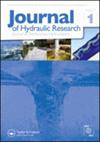基于部分饱和法的浅水流动离散Boltzmann模型弯曲边界处理
IF 1.7
3区 工程技术
Q3 ENGINEERING, CIVIL
引用次数: 0
摘要
在本研究中,将一种称为部分饱和法(PSM)的边界处理方案纳入浅水流的离散玻尔兹曼模型(DBM)中,以处理复杂的弯曲边界。在该PSM-DBM中,采用二维16速度水平格式,并采用有限差分法求解控制方程。然后,应用PSM-DBM模拟了四种情况,即弯曲通道中的稳定流动、经过固定圆柱体的流动、圆形盆地中的射流强制流动和具有90°连续弯曲的弯曲通道中流动。将模拟结果与实验结果和传统数值模拟结果进行了比较。研究表明,模拟结果与实验结果吻合良好。结果表明,PSM-DBM在处理曲线边界时是稳定和准确的。此外,PSM的实施在处理静止曲线几何结构方面相对简单,并且易于纳入浅水流的DBM中。总之,所提出的PSM-DBM可以广泛用于具有弯曲边界的流动。本文章由计算机程序翻译,如有差异,请以英文原文为准。
A curved boundary treatment for discrete Boltzmann model of shallow water flows based on a partially saturated method
In the present study, a boundary treatment scheme named the partially saturated method (PSM) is incorporated into the discrete Boltzmann model (DBM) for shallow water flows to deal with complex curved boundaries. In this PSM-DBM, the two-dimensional 16 velocity levels scheme is adopted and the finite difference method is used to solve the governing equation. Then, the PSM-DBM has been applied to simulate four cases, i.e. such as steady flow in a bending channel, the flow past a stationary cylinder, a jet-forced flow in a circular basin and flow in a meandering channel with 90° consecutive bends. The simulated results have been compared with the experiments and the simulation by traditional numerical simulation. The study shows that the agreement between simulation and experiments is good. It is demonstrated that the PSM-DBM is stable and accurate to deal with the curved boundaries. Moreover, the implementation of the PSM is relatively straightforward in treating stationary curved geometries and is easy to be incorporated into the DBM for shallow water flows. In conclusion, the proposed PSM-DBM can be used widely for flows with curved boundaries.
求助全文
通过发布文献求助,成功后即可免费获取论文全文。
去求助
来源期刊

Journal of Hydraulic Research
工程技术-工程:土木
CiteScore
4.90
自引率
4.30%
发文量
55
审稿时长
6.6 months
期刊介绍:
The Journal of Hydraulic Research (JHR) is the flagship journal of the International Association for Hydro-Environment Engineering and Research (IAHR). It publishes research papers in theoretical, experimental and computational hydraulics and fluid mechanics, particularly relating to rivers, lakes, estuaries, coasts, constructed waterways, and some internal flows such as pipe flows. To reflect current tendencies in water research, outcomes of interdisciplinary hydro-environment studies with a strong fluid mechanical component are especially invited. Although the preference is given to the fundamental issues, the papers focusing on important unconventional or emerging applications of broad interest are also welcome.
 求助内容:
求助内容: 应助结果提醒方式:
应助结果提醒方式:


